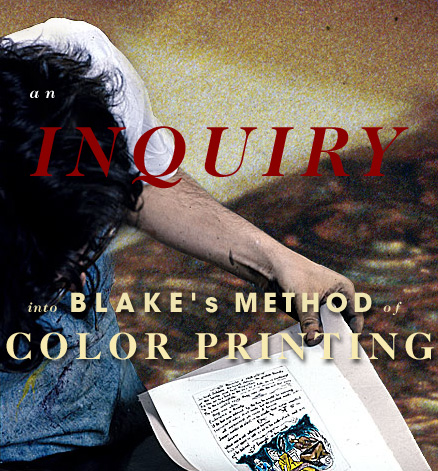|
|
|
|
|
0:
SUGGESTIONS FOR READERS FOR OPTIMAL VIEWING 1: INTRODUCTION 2: BACKGROUND & CONTEXT 3: BLAKE'S COLOR PRINTING METHODS 4: THE TWO-PULL THEORY 5: THE ARGUMENTS FOR AND AGAINST TWO-PULL PRINTING 6: WHY "NURSES SONG" WAS PRINTED TWICE 7: OCCAM'S RAZOR 8: POSTSCRIPT: SOME IMPLICATIONS 9: NOTES 10: 11: WORKS CITED |
|
1: INTRODUCTION |
|
ver the last thirty years,
William Blake’s methods of etching the copperplates of his illuminated
books have received more scrutiny than the ways he printed those plates.
In 2000, however, printing techniques rose to the forefront of attention
among the small band of scholars interested in how Blake made his books
as the material foundation for interpretations of what they mean. Credit
is due to Michael Phillips, for many years a well regarded bibliographic
and historical scholar of Blake’s life and works, for raising the issue
of Blake’s color printing methods and thereby stimulating the debate
we wish to initiate in this essay. Phillips proposes that Blake created
color-printed impressions of his relief etchings by passing them through
his rolling press twice, once to print the text in ink and a second
time to color print the design on the same sheet of paper. This “two-pull”
procedure (as we will call it throughout this essay) differs fundamentally
from a “one-pull” procedure, in which the inked text and the colored
image are printed simultaneously in one pass through the rolling press.
The first, prominent appearance
of his theory, one that attracted wide attention, was in the catalogue
(Hamlyn and Phillips 106-07, 118) and wall labels for the great Tate
Britain Blake exhibition, London, fall and winter 2000-01. The museums and publishers presenting the two-pull theory cannot fail to attract considerable respect. It is difficult to imagine more prestigious art-historical institutions than the Tate and the Met. The British Library and Princeton University Press lend similar authority to Phillips’ book. We assume that both publishers solicited the advice, and received the approval, of leading authorities in Blake and the graphic arts. The positive reception of Phillips’ book is indicated by Vincent Carretta’s and K. E. Smith's glowing reviews in Eighteenth-Century Studies and The Blake Journal respectively. But before the two-pull theory achieves complete acceptance within the community of Blake scholars, we wish to raise some serious reservations concerning its accuracy. We do so within the context of a thorough examination of Blake’s color prints, their minute visual features and the processes that created them, as well as their relationship to the color-printing technologies of the eighteenth century. We will also explain (and question) how the two-pull hypothesis implies a “Blake” very different from the artist, poet, and aesthetic theorist Blake himself portrays explicitly in his writings on the arts and implicitly throughout his graphic productions. Although we disagree strongly with Phillips’ theory, we are grateful to him for bringing to our attention the technical issues and their larger conceptual implications we consider in what follows. As Blake wrote in The Marriage of Heaven and Hell, “Opposition is true Friendship” (E 42). |
|
| 0:
SUGGESTIONS FOR READERS FOR OPTIMAL VIEWING 1: INTRODUCTION 2: BACKGROUND & CONTEXT 3: BLAKE'S COLOR PRINTING METHODS 4: THE TWO-PULL THEORY 5: THE ARGUMENTS FOR AND AGAINST TWO-PULL PRINTING 6: WHY "NURSES SONG" WAS PRINTED TWICE 7: OCCAM'S RAZOR 8: POSTSCRIPT: SOME IMPLICATIONS 9: NOTES 10: LIST OF ILLUSTRATIONS 11: WORKS CITED |
|
|
designed in collaboration with
the UNC-CH
Center for Instructional Technology
|
|

